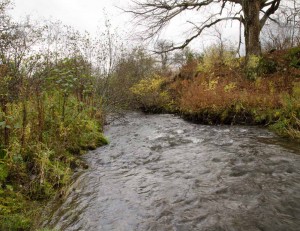Butternut Creek
Butternut Creek is a small North-South running stream extending some thirty-five miles throughout the length of the Butternut Valley. Greenwoods Conservancy protects the stream as it emerges from wooded and brush covered terrain 3.69km from its source at Basswood Pond, a NYSDEC* created shallow body of water designed for trout habitation and access for fishing. Its half mile course through Greenwoods is shrouded with Speckled Alders backed up by a steep dense forest to the East.
The “Butternut” drains a narrow glacier created valley dating back some 15,00 years from the time the Wisconsin glacier was retreating northward. For the prior 15,00 to 100,00 years the valley had been covered by an ice sheet up to a mile in thickness that had scraped and scoured the land to create its current hilly terrain.
Inhabited for thousands of years by native peoples the valley was first populated by white settlers in the late 1700’s. Lumbering and subsistence farming gave way to larger dairy farms and small manufacturers. A number of water powered mills dotted the stream banks and several small communities emerged. Manufacturing ceased in the late 1800’s and few dairy farms remain today.
The hamlets of Burlington Green and Garrattsville anchor the northern end and the villages of Morris and Gilbertsville developed alongside the Butternut as it traversed southward on its way to the confluence with the Unadilla River and later the Susquehanna River near Sidney, New York. Its ultimate terminus is the Chesapeake Bay on Maryland’s Eastern Shore.
Barely two meters wide as it enters and emerges from Greenwoods the stream is described as “non-impacted” with very good water quality. Both water temperature and high dissolved oxygen content support health Brook Trout population and nursery. The stream is regularly monitored by NYSDEC and irregularly electro shocked to determine fish numbers and diversity.
An excellent and detailed description of the Butternut can be found in a thesis submitted by Michael F Stensland for his Masters of Arts degree at SUNY Oneonta. That thesis is reproduced in its entirety on the Biological Field Station’s website under Publications (2002) and can be viewed by clicking here.
*NYSDEC. New York State Department of Environmental Conservation.

